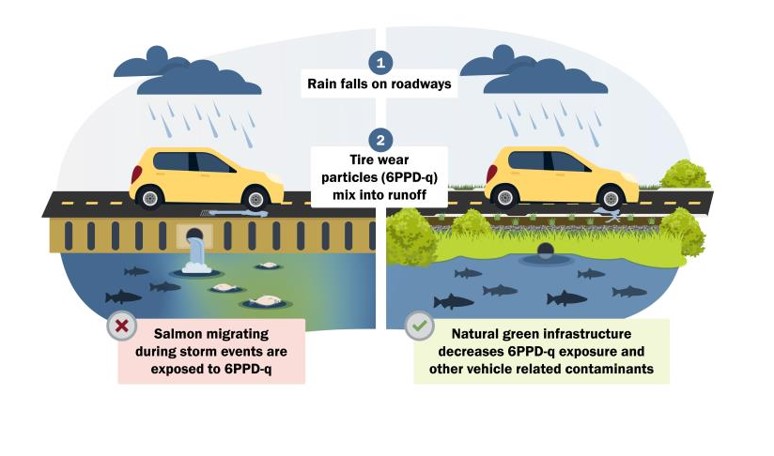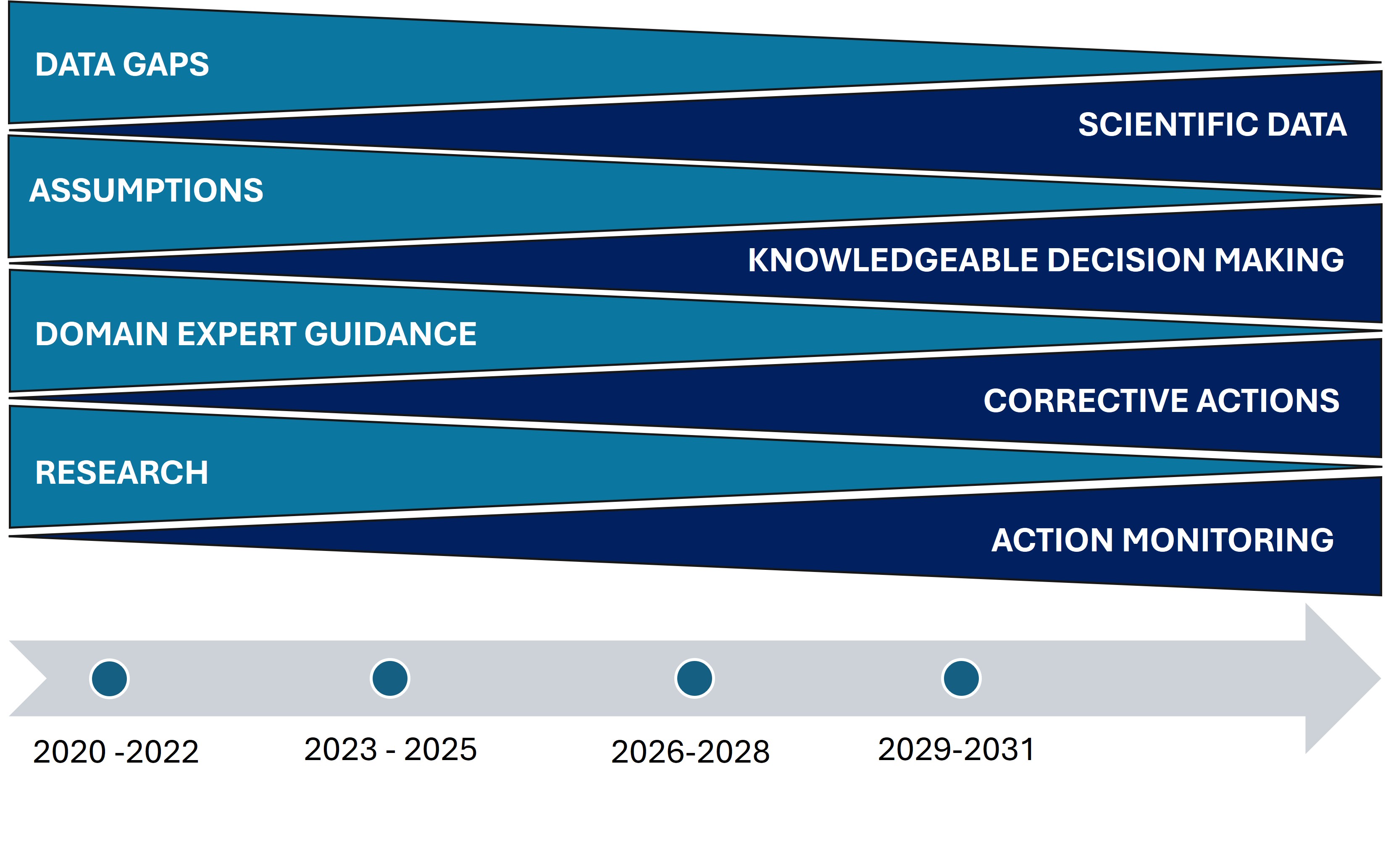
The Washington Department of Ecology is conducting 6PPD-quinone (6-PPDQ) research and monitoring to understand the impacts on aquatic life. Trace amounts of 6-PPDQ cause coho salmon mortality within hours of exposure. Ecology and university partners are conducting additional tire chemical toxicity studies on other resident aquatic life while seeking safer alternatives to 6PPD in tires. Ecology and partners are conducting sampling surveys of critical areas, such as small urban streams and wetlands, to understand where 6-PPDQ is limiting biological recovery of urban watersheds. The sampling results will be used to locate toxic reduction corrective actions.
GOAL: The toxics ecosystem assessment data will be used to locate corrective actions to protect aquatic life from road runoff within priority watersheds. Priority watersheds refer to those chosen by regional community and technical advisory groups.
BONUS: These efforts will provide critical baseline data that can monitor the success of our corrective actions.
.jpg)
Toxics Ecosystem Assessment Plan for 6-PPDQ
- 2026- continue integrated and spatial toxics ecosystem assessments to identify places and species that are impacted by 6-PPDQ.
- 2025- identify vulnerable aquatic ecosystems impacted by urban road runoff and integrate data into ongoing stormwater mapping and modeling efforts.
- 2024 - began to implement the toxics ecosystem assessment strategies to verify critical areas of concern using 6-PPDQ as an urban runoff proxy.
- 2023 - conducted method developement, stream reconnaissance, and evaluated priority watersheds mapping strategies.
- 2022 - convened salmon and mapping domain experts who developed mapping strategies to identify priority watersheds.

2026
Research Planning
Risk assessment research and monitoring: Ecology is partnering with state, county and federal agencies to develop sampling methods, conduct 6PPDQ toxicity studies, and provide research training at workshops. Our research projects are listed below:
- Identifying where 6PPDQ and coho salmon are most prevalent to better understand the impacts to these fish. correlating coho salmon and 6PPDQ occurrence estimates to understand the impact on populations. Our partners include King County, Kitsap County, the Washington Department of Fish and Wildlife (WDFW), Suquamish Tribe, and Trout Unlimited.
- Conducting field and lab studies to understand how 6PPDQ impacts amphibian species in urban wetlands. Our partners include WDFW’s Habitat and Toxics Biological Observation System programs and Washington State University – Vancouver. This work is part of a funded project through the Puget Sound National Estuary Program.
- Collaborating with the United States Geological Survey to study the effectiveness of existing structural stormwater features meant to capture, control, and filter 6PPDQ from stormwater. This work is part of a funded project through the Puget Sound National Estuary Program.
- The Toxics Ecosystem Assessment Program and the Manchester Environmental Laboratory (MEL) continues to work closely with our research partners to develop and evaluate sampling methods for measuring 6PPDQ in water and solids. A survey conducted in fall of 2024 with King County and the United States Geological Survey supports the use of passive samplers as an effective screening tool for comparing 6PPDQ mass loading among watersheds.
2025
Research Activities
- The integrated urban watershed study will continue; stream water quality and quanity (flow) and 6-PPDQ concentrations are measured at 2 hour intervals for 24 hours during storm events to correlate the persistence and peak concentrations of 6-PPDQ persists with stream biological indicators.
- Source idenfication assessments will continue that compare 6-PPDQ mass loadings among streams in priority watersheds, these surveys are a joint effort with many partners.
- 6-PPDQ in marine sediment samples will be collected throughout the Puget Sound as an indicator of urban runoff impacts.
- Science staff will continue to participate in interstate, tribal and federal coordination groups and build collaborative relationships with partners.
2024
QA/QC Planning & Research Products
- A Tire Contaminant Storymap was completed and published.
- An interactive 6-PPDQ in Watersheds Risk webmap was developed and available online to help visualize areas with greater traffic, runoff and critical areas of concern.
- A small stream survey was conducted with USGS and King County to compare 6-PPDQ mass loading with other small urban streams.
- An integrated urban watershed study began aimed to help us understand the persistence of 6-PPDQ throughout a storm among seasons and land uses.
- Provided on-demand technical training to Tribal partners to support their sampling efforts.
- Published a sampling 6-PPDQ in receiving waters SOP that was reviewed by subject matter experts.
2023
6-PPDQ Field and Lab Method Development & Verification
- Methods were developed to measure 6PPD-quinone in water and solids.
- Passive sampling methods were evaluated by conducting a lake study.
- A method device study was implemented to compare passive, active and manual sampling techniques.
- A Quality Assurance Project Plan: 6PPDQ Priority Area Assessments was developed and published.
2022
Priority Watershed Assessment Strategies Proviso Work - Strategic Planning Technical Advisory Group and Legislative Report
An urban road runoff technical advisory committee shared research updates, prioritized data gaps, and developed strategies to visualize and focus where 6-PPDQ is impacting vulnerable aquatic life. A summary of recommendations and current knowledge was published in a 6PPD in Road Runoff Legislative Report. This process of evaluating the current knowledge regarding the impact of tire contaminants on aquatic life helped galnanize pro-active state, tribal and federal working groups to address the tire contaminant problem. Please find the a list of the SME presentations below and the final report that also included an evaluation of Best Management Practices (BMPs) effectiveness to reduce 6-PPDQ transport to waterbodies.
6PPD Road Runoff Assessment and Mitigation Strategies Legislative Report Final
Summary of Recommendations from Report
Identifying Priority Areas for Corrective Actions to Reduce Urban Runoff Impacts to Aquatic Life
- Integration of urban stream and wetland quality and quantity will accelerate recovery of aquatic ecosystems.
- To identify where to protect species and habitats from urban runoff, we need to know where and when they are being exposed to 6-PPDQ.
- 6-PPDQ peak concentrations in urban small streams and wetlands should be used as a metric for project prioritizations.
- Tribal Treaty Rights is a priority.
- Human health benefits is a priority.
- Protecting and restoring small streams and coho salmon habitat is a priority.
- Toxicity studies of additional Washington resident aquatic life is a priority data gap.
- The fate and transport of 6-PPDQ in the evironment is a priority data gap.
Evaluating Stormwater Best Management Practices that Reduces 6-PPDQ in Urban Runoff
Several strategies were identified to be, most likely, effective at reducing the discharge of 6-PPDQ to receiving waters:
- Source control BMPs, for example street sweeping and line cleaning may help reduce tire wear particle mass loading.
- Structural BMPs that that mimic natural filtration processes and minimize impervious surfaces, for example, green infrastructure, low impact development, and emerging technologies may help reduce 6-PPDQ transport and impact to aquatic life.
- More studies are needed to understand the cost and feasibility of BMPs to effectively manage 6-PPDQ in stormwater.
Status of Recommendations from Report
Identifying Priority Areas for Corrective Actions to Reduce Urban Runoff Impacts to Aquatic Life
- Stormwater SIL funded local entities to conduct local 6-PPDQ prioritizations.
- MTCA funds were awarded to Ecology to evaluate sampling methods, develop analytical lab methods and a study design to assess 6-PPDQ in urban waterways, and fund UW-Tacoma to evaluate fate and transport data gaps.
- Continued MTCA funds are being requested for the toxics ecosystem assessments.
- A project to inventory and integrate stream and wetland habitat quality and quantity for each salmon recovery watershed has not been funded.
Evaluating Stormwater BMPs that reduces 6-PPD in road runoff
- Stormwater SIL and other stormwater funding programs have invested in research projects to evaluate BMP effectiveness.
- Project list and status are available on the Stormwater 6-PPDQ funding site.
- Biochar, in particular, has been highlighted as an effective media for reducing 6-PPDQ in runoff and avoiding coho salmon mortality.
- The benefits, feasibility and cost of street sweeping is being evaluated.
6-PPDQ Priority Watershed Technical Advisory Committee Meetings - Domain Experts Input
May 18, 2022
Presentations
May 10, 2022 - GIS Expert Workshop
Presentations
March 30, 2022
Presentations
March 7, 2022
Presentations
February 23, 2022
Presentations

Please Wait...
.jpg)